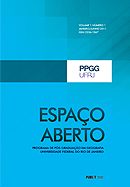Modeling in Physical Geography: Theory, Potentialities and Challenges
DOI:
https://doi.org/10.36403/espacoaberto.2016.5243Keywords:
modeling, prediction, validation, landslide, soil erosion, future scenarios, simulation, dynamic equilibrium, relaxation, sensibilityAbstract
Modeling must be considered as an important analytical tool inside the different areas of physical geography. This paper discusses the general usage of models in physical geography, focusing on their theoretical basis, potential applications and major future challenges. Models applied to studies concentrated on prediction, retrodiction and hypothesis testing are presented. Here, main emphasis is on mathematical models, including those based on empirical, deterministic and stochastic relationships, discussing the potentialities and limitations of concentrated and distributed models, as well as those associated with transient and steady-state models. In parallel, the differences related to the steps of parameterization, calibration, validation and verification during the modeling processes are presented. At the end, the main problems and challenges required to achieve an effective usage of the modeling tools in physical geography are discussed, especially those focusing on the relationships between modeling and scientific methodology, the question of equifinality and the determination of the associated uncertainties. In fact, the review presented here shows that models with high prediction success may not necessarily represent “good models” in theoretical aspects. In order to continue its consolidation as an important analytical tool inside the different physical geography fields, model users need to focus on achieve a better understanding both on the mechanisms controlling the system to be modelled and the model itself, in terms of its internal structure and the associated hypotheses. Otherwise, the model user will be only a “software pilot”, wasting the opportunity of turning the beautiful resulting maps in effective tools of scientific analyses.


